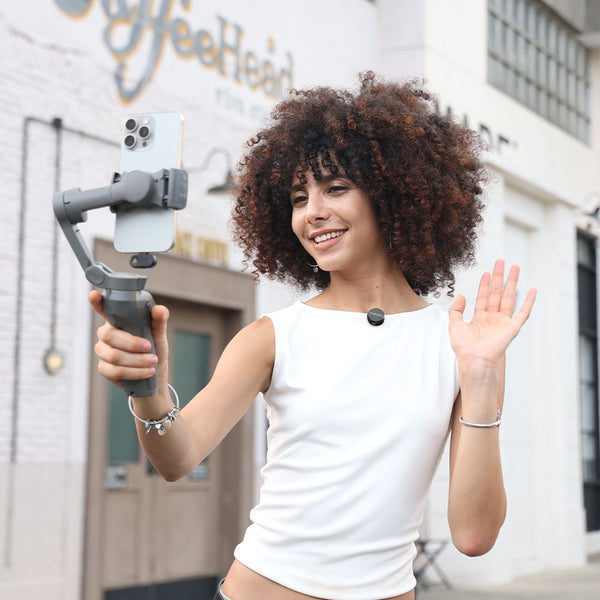Have you watched a video teaching pronunciation or vocabulary recently? If you watched it until the end, chances are the audio was clear, right? Exactly—and because you can still remember watching that video, it shows that quality audio is essential for learning pronunciation or mastering vocabulary. In this article, we’ll explore how good audio helps with information retention and language learning, and how a wireless lav mic for Android or other compact wireless lavalier devices make it all possible.
In the world of digital learning, audio quality can make or break your content. Whether you’re creating short English lessons for social media or filming pronunciation tutorials for YouTube, crisp and clear audio is essential. When learners can hear every syllable, tone, and intonation, they absorb vocabulary more effectively and develop accurate pronunciation skills. That’s why using a cheap wireless microphone or the best budget lavalier mic can elevate the quality of your educational videos and make your content stand out from the crowd.

How Audio Quality Impacts Learning Vocabulary in Short-Form Content
Short-form videos thrive on clarity and engagement. In pronunciation or vocabulary lessons, your voice is the main instrument. Poor audio can cause distractions or misunderstandings—viewers may hear “ship” instead of “sheep,” or “bat” instead of “pat.” Such confusion weakens language comprehension.
Clear audio helps learners:
-
Differentiate between similar sounds (like /p/ and /b/).
-
Recognize stress and rhythm in natural speech.
-
Stay engaged longer because the content feels professional and easy to follow.
The Role of Wireless Microphones in Enhancing Pronunciation Tutorials
Wireless microphones eliminate the limitations of wired setups. You can move freely while maintaining high-quality audio—ideal for creators who record standing shots, gestures, or expressive speaking activities. They’re also compact, easy to use, and connect seamlessly with smartphones or cameras, making them perfect for creators producing short educational content for TikTok, Instagram Reels, or YouTube Shorts.
How to Use a Wireless Microphone for Clear Speech in Short English Videos
Using a wireless mic correctly ensures your pronunciation and vocabulary videos sound professional. Here are key tips:
-
Position the mic properly — Clip it about 6–8 inches from your mouth, usually near your collarbone, for optimal clarity without distortion.
-
Minimize background noise — Record in a quiet space or use noise-cancelling features.
-
Test before filming — Say a few lines and listen for volume consistency, breath sounds, or distortion.
-
Maintain consistent distance — Avoid turning your head too far from the mic while speaking.
Recommended Wireless Microphones
-
Maono Wave T5 Wireless Microphone

-
Designed for content creators and educators, the Maono Wave T5 delivers professional-grade sound with dual-channel recording and long transmission range.
-
Its intelligent noise cancellation ensures that your voice remains clear, even in moderately noisy environments.
-
It connects easily to smartphones, cameras, and laptops, making it ideal for teachers, vloggers, and language instructors.
-
Why it’s great for pronunciation videos: Its natural vocal capture reproduces tone and clarity accurately, helping learners distinguish subtle sound differences. It’s an excellent, best budget lapel mic option for those who want quality without overspending.
-
Maono Wave T1 Mini Wireless Microphone

-
Compact yet powerful, the Maono Wave T1 Mini is perfect for on-the-go short-form content creators.
-
It provides plug-and-play convenience—just connect and start recording instantly.
-
With real-time monitoring and high-fidelity transmission, it ensures smooth pronunciation demonstrations.
-
Why it’s ideal for vocabulary videos: Its lightweight design and portability make it easy to record anywhere, whether you’re indoors, in classrooms, or outdoors. For Android users, pairing it with a wireless lav mic for Android setup makes it an affordable and efficient recording choice.
Recording English Pronunciation Drills for Social Media with a Wireless Mic
When recording pronunciation drills, clarity and pacing are key. Wireless microphones capture the subtleties of your articulation, which helps viewers follow and mimic you accurately. Try these steps:
-
Break down words by syllables: Speak slowly and clearly using examples (“pho-to-graph,” “re-cord”).
-
Emphasize stress and intonation: Use your wireless lavalier to highlight changes in tone or emphasis.
-
Include minimal pairs: Compare similar sounds (“ship/sheep,” “bat/bet”) to train learners’ ears.
You can film these drills as short, engaging videos—ideal for quick daily pronunciation challenges.
Best Practices for Recording Vocabulary Lessons with a Wireless Mic
-
Script before recording – Plan your lesson and vocabulary examples to ensure smooth delivery.
-
Keep it short and focused – 15–60 seconds is perfect for platforms like TikTok or YouTube Shorts.
-
Use gestures and visuals – Clip your best budget lavalier mic securely to your shirt.
-
Monitor sound quality – Many wireless mics, like the Maono Wave series, offer real-time monitoring to ensure consistent audio.
-
Record in batches – To maintain consistency in audio and tone, record multiple lessons in one session.
Step-by-Step Guide to Creating Short Pronunciation Practice Clips
-
Plan your content: Choose 3–5 target words or sounds to teach.
-
Set up your recording space: Quiet environment, minimal echo, and proper lighting.
-
Attach your wireless mic: Make sure it’s securely clipped and not rubbing against fabric.
-
Test your audio: Record a short sample and adjust gain levels.
-
Record your pronunciation: Speak naturally, exaggerating slightly for clarity.
-
Add visuals and text overlays: Display the word and phonetic spelling for learners.
-
Edit and enhance: Trim pauses, adjust audio levels, and add captions for accessibility.
-
Publish and engage: Post consistently and respond to viewer comments or pronunciation challenges.
Combining Visuals and Audio for Effective Vocabulary Learning Shorts
A balanced mix of visuals and high-quality audio enhances understanding. Visual cues (such as showing mouth movements or text on screen) support auditory learning. Use on-screen examples, emojis, or props to reinforce meaning, your wireless lavalier ensures that every sound is distinct.
This dual-channel learning—visual and auditory—accelerates vocabulary retention. Learners not only hear the correct pronunciation but also connect it visually, strengthening long-term memory.
Editing Tips for Pronunciation Videos: Enhancing Clarity and Sound
Post-production can polish your audio and video:
-
Normalize audio levels so your voice remains steady throughout.
-
Remove background hums using editing tools like CapCut, Adobe Premiere Rush, or Audacity.
-
Add subtitles for accessibility and comprehension.
-
Use filters sparingly—the focus should remain on your pronunciation.
-
Sync audio and visuals precisely so lip movements align with speech.
These finishing touches make your short educational clips both professional and engaging.
FAQs:
1. What type of wireless microphone is best for recording pronunciation videos?
A lavalier or clip-on wireless mic, like the Maono Wave T5 or T1 Mini, is ideal. Both models are great options for anyone looking for the best budget lapel mic setup.
2. How can I make my voice sound clearer when teaching vocabulary on camera?
Speak slowly, enunciate each syllable, and ensure the mic is positioned correctly. Avoid speaking too close to the mic to prevent plosive sounds.
3. Do I need noise cancellation in a wireless mic for short language videos?
Yes. Noise cancellation helps reduce unwanted sounds, keeping your speech crisp and professional.
4. How close should the wireless mic be to my mouth for the best pronunciation clarity?
Place it about 6–8 inches from your mouth, usually near your chest or collar area.
5. Can I use my smartphone with a wireless mic to record vocabulary videos?
Absolutely. Most wireless mics, including Maono models, connect easily to smartphones via USB-C or Lightning ports.
6. What are some affordable wireless mics for beginner English content creators?
The Maono Wave T1 Mini and similar cheap wireless microphone options provide professional sound without breaking the bank.
7. How do I reduce echo or background noise when recording in my room?
Use curtains, carpets, or foam panels to absorb sound. Always record with the door closed.
8. What’s the best app to record and edit short pronunciation videos?
CapCut, InShot, and Adobe Premiere Rush are user-friendly for editing short educational clips.
9. How long should short vocabulary videos be for better audience engagement?
Keep them between 15 to 60 seconds—long enough to teach one or two new words clearly.
10. How can I use captions or on-screen text to reinforce new vocabulary?
Add phonetic transcriptions and example sentences to help learners visualize pronunciation and meaning.
11. Should I use a lavalier mic or a clip-on wireless mic for pronunciation clips?
A clip-on wireless mic is ideal—it’s hands-free and ensures consistent audio even as you move.
12. What lighting setup works best when recording short speaking practice videos?
Use a ring light or softbox facing you to reduce shadows and highlight facial expressions.
13. How can I train my pronunciation before recording my short clips?
Practice tongue twisters and record test clips to identify unclear sounds.
14. What are common pronunciation mistakes I should highlight in my videos?
Focus on vowel distinctions, silent letters, and word stress patterns that learners often miss.
15. How can I make my vocabulary lessons sound more natural on camera?
Speak conversationally, use real examples, and smile to create a friendly tone.
16. How do I sync audio from a wireless mic with my video during editing?
Use your editing software’s sync feature or align the waveform manually by matching claps or speech starts.
17. What are some fun short-video formats for vocabulary learning?
Try “Word of the Day,” pronunciation challenges, or interactive quizzes.
18. How can I monitor my audio in real time while recording with a wireless mic?
Use apps or earbuds compatible with your wireless lav mic for Android devices for real-time monitoring. When using Maono Wave T5 or the T1 Mini, download the Maono link software for real-time audio full customization.
19. What are effective ways to test microphone sound levels before filming?
Record a short clip, listen back, and adjust the gain if your voice peaks or sounds too soft.
20. How can I make my short videos stand out on TikTok or YouTube Shorts while teaching pronunciation?
Use catchy visuals, creative transitions, and background music—while keeping the voice track clear and natural.
Conclusion
Creating short videos to improve pronunciation and vocabulary doesn’t require studio-grade gear—just a reliable wireless lavalier microphone and a thoughtful setup. High-quality audio builds trust, ensures clarity, and keeps learners engaged.
By using tools like the Maono Wave T5 or Wave T1 Mini, you can deliver professional-level content without spending much. Both models are among the best budget lavalier mic options for creators aiming for clean, natural sound. Combine clear speech, expressive visuals, and a cheap wireless microphone, and you’ll transform simple clips into powerful learning tools.
In short, with a great voice, a wireless lav mic for Android, and your creativity—you can redefine how people learn pronunciation and vocabulary, one short video at a time.
Also Read:
How to Use a Lavalier Bluetooth Microphone: Clip-On Shirt Mic Guide



